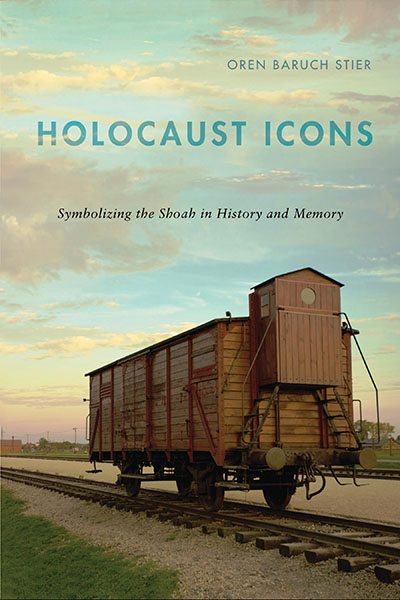Symbols of the Holocaust
Targum Shlishi helped support Oren Baruch Stier’s book Holocaust Icons: Symbolizing the Shoah in History and Memory (Rutgers University Press). In the book, Stier explores what he calls Holocaust icons, which are symbols that have essentially become stand-ins for the Holocaust. The four symbols he looks at in the book are:
 World War II-era railway boxcars,
World War II-era railway boxcars,- the “Arbeit macht frei” slogan and gateway,
- the persona of Anne Frank, and
- the number “six million.”
Stier is a professor of religious studies at Florida International University. He is also the author of the book Committed to Memory: Cultural Mediations of the Holocaust (University of Massachusetts Press, 2003).
Rutgers University Press has generously offered our readers a 30 percent discount plus free shipping on Holocaust Icons. Go here to purchase the book and at check out use code 02JWDM12.
The following is an excerpt from Holocaust Icons by Oren Baruch Stier.
Introduction: Holocaust Symbols: The Shapes of Memory
“….Among other legacies, the Holocaust bequeathed to contemporary society a cultural lexicon, as it were, of powerful symbols. This is a book about those symbols and the symbolization process; it is about the symbols used culturally to refer, whether directly or obliquely, to the Holocaust, and about how they came to be used in this way. It is in interacting with this symbolic vocabulary that people today, nearly seventy years after World War II’s end, come to feel they know something about the Holocaust. But what do these images and artifacts really communicate? In addition to their emotional impact, these symbols appear to convey the essence of the Holocaust: its bureaucracy, its depravity, its poignancy. But the most common Holocaust symbols do not directly communicate its brutal violence. This is one of the reasons these particular images and artifacts are so recognizable and so powerful: they are representative without being overwhelming, succinct without being too graphic.
Most especially, this book is about certain symbols that have come to represent the Holocaust in encapsulated form—those that summarize complex narratives of the Shoah, simplifying, condensing, and distilling these narratives and producing meanings for cultural consumption: I call these symbols Holocaust icons. They span a range of overlapping cultural representations in material, linguistic, literary, photographic/cinematic, and numeric terms. The icons I have selected, those I think represent the essence of the referential process, together with their analysis suggest that it is through the use of iconic symbols that the public meanings and perceptions of the Holocaust are created, even when (and especially when) the distillation process that produces these icons strips out much of the historical context and specificity of each icon. Indeed, the more we see and hear about the Holocaust in the twenty-first century, the less we seem to actually know. But what if we could restore to these icons their own histories? My project here is to re-infuse each selected icon with its own past, thus allowing us to better apprehend its significance.
My selection of icons relates in part to another mark of Holocaust memorialization and representation in the present, what Hirsch remarks as the “striking repetition of the same very few images, used over and over again…emblematically to signal” the Holocaust. Hirsch understands these repeated images as tropes (that is, forms of expression signifying recurring themes) “for Holocaust memory itself….It is as such tropes, and not for their informational value about the Holocaust, whether denotative or connotative, that they are incorporated into the visual landscape of post-memory as pervasively as they are. And, at the same time, the repetition also underscores their figurative role.” The four icons I analyze in the central chapters of this book are images that recur and have come to symbolize certain recurring themes: the Holocaust-era railway car, the “Arbeit macht frei” slogan and gateway, the persona of Anne Frank, and the number “six million.” We come to understand that what sets these icons apart from mere symbols are the ways each one has come to so completely embody and encapsulate the Shoah, allowing each to serve as a metonym for it—as, that is, an aspect, artifact, or adjunct of the Holocaust that stands in for the whole. This is not a book about Holocaust art, though some works of art, including some about the Holocaust, will be referred to. Rather, this is a book about a selection of symbols—an object, a phrase, a person, and a number—originating in the Holocaust era, and about how these have been transformed into icons of the Holocaust and of its memory. I engage this selection of icons on two levels: the first, the historical, places them in their Holocaust (and, in some cases, pre-Holocaust) context, asking where they came from and what, if anything, they meant when first noted; the second, which might be called the representational or memorial level, places these same items in their post-Holocaust context, asking how they have been used and appropriated, how they have evolved, how they have been reproduced, and to what ends. In other words, I am interested here in both the life and the afterlife of Holocaust symbols.”
From: “Introduction: Holocaust Symbols: The Shapes of Memory,” Holocaust Icons: Symbolizing the Shoah in History and Memory, Oren Baruch Stier (Rutgers University Press, 2015).
Images: Crop of and full cover, Holocaust Icons: Symbolizing the Shoah in History and Memory, courtesy of Rutgers University Press.
